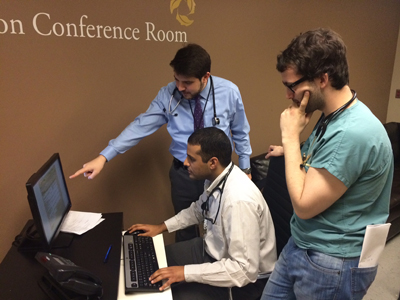
Residents and Physicians collaborating to complete a Discharge Summary at TGH General Internal Medicine. (Photo: SIMS)
Every year at UHN, about 35,000 inpatients are discharged and 46,000 discharge summary reports are delivered to primary care providers.
Patients' follow-up care relies on the quality, completion, and delivery of discharge reports.
Over the past few months, UHN has been working on a quality improvement plan for discharge summaries. By focusing on standardization, quality improvements, and changes to clinical practices, UHN aims to support a more seamless care continuum and patient-centred care for its discharged patients.
Did you know?
Under the Ontario Public Hospitals Act, UHN is obligated to complete a Discharge Summary for each inpatient.
A discharge summary that captures the complexity and course of treatment for the patient's hospital stay forms the basis for accurate clinical coding of each inpatient visit and ensures optimal allocation of Ministry funding
UHN can send a Discharge Summary to a primary care provider in just 30 minutes of it being completed
According to the Ministry of Health and Longterm Care, delayed discharge information provided to subsequent care providers is one of the factors contributing to 20 per cent of patients experiencing adverse events during the first several weeks after a hospital discharge
The risk of re-hospitalization decreases when patients are assessed for follow-up by physicians who received a timely Discharge Summary
Family Physicians rated Discharge Summaries as being of high quality when they were short, delivered quickly, and contained pertinent data that concentrated on discharge information
For more information please contact UHNQIPDischargeSummary@uhn.ca
To support this initiative, a physician group was established, including the VP Medical Affairs & Quality, Chiefs of Surgery & Medicine, and five additional physician leaders. Three expert panels have also been convened to identify and investigate all opportunities to improve the discharge summary process.
"Getting better at the discharge summary process and understanding its utility for patients and community care providers will strengthen connections between organizations and the patient," says Dr. Charlie Chan, VP Medical Affairs and Quality.
A valuable tool for care providers
Discharge summaries are useful tools for patients and their families to help them understand what happened during their stay at the hospital. Having this type of information enables patients to be partners in their own care. It allows them to have quality discussions with their care providers about their ongoing treatment.
"It is critical that patients understand their follow-up instructions, and the letter allows this information to be presented in a written format. Overall, the discharge summary is a very valuable tool for the dissemination of information," says Meredith Linghorne, Nurse Practitioner at the Peter Munk Cardiac Centre.
As a legal record of the information and counsel the care team has provided the patient, it's also a vital communication tool for care providers.
"It is your last chance to communicate with your patient about what they need to remember when they leave your care, and it also informs referring physicians with the information they need to continue the care continuum," says Marina Vainder, obstetrics and gynecology resident at TWH.
A sneak peek of upcoming changes
UHN is committed to establishing a standard approach to documenting a discharge summary to:
- Align with other Toronto Central Local Health Integration Network (LHIN) healthcare institutions
- Complete a discharge summary within two days of the patient being discharged
- Send a discharge summary to the referring/family physician within three days of completion
- Ensure Most Responsible Provider (MRP) accountability for the accuracy of all completed discharge summaries
